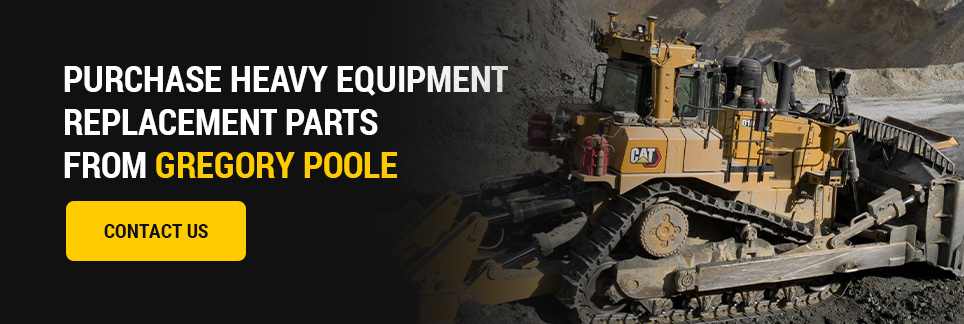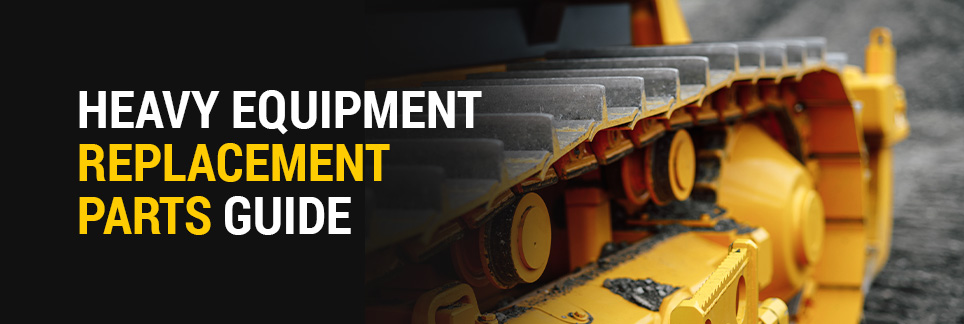
Replacing heavy equipment parts is an important part of routine maintenance. By replacing parts before they fail, you can keep your machine running as efficiently as possible while preventing costly breakdowns and downtime. You also increase your equipment’s life span for your overall success. Exploring part options and considerations helps you prepare for upcoming replacements.
The better prepared you are, the faster you can change parts and get your equipment back to work. Continue reading to learn about heavy equipment replacement parts, including how to source and select the right components.
Heavy equipment replacement parts are components specifically designed to replace worn, damaged or failed parts in heavy machinery. They play a critical role in keeping your heavy equipment functioning efficiently, with various types of replacement parts meeting the needs of different machinery.
Parts can vary from basic wear components like filters and belts to complex hydraulic systems and engine parts. Whether you opt for new, used or remanufactured parts, you’ll find options for bulldozers, excavators, cranes, loaders and other heavy machinery models. Replacing these parts before or as soon as you notice issues can help you extend the life span of your equipment, optimize performance and reduce downtime.
Replacing parts can also lead to cost savings by preventing more extensive damage due to neglected maintenance.
You’ll know when to buy replacement parts by doing regular inspections during routine maintenance. How often you replace your equipment’s parts can also depend on the specific component. Here are some signs it’s time to replace components:
Be sure to train your operators on heavy equipment replacement part maintenance to identify early warning signs of potential part failures. You might also adopt a proactive approach by replacing certain critical parts based on historical data to avoid unexpected breakdowns while working.
Understanding the types and functions of heavy equipment parts is critical to replacing them effectively.
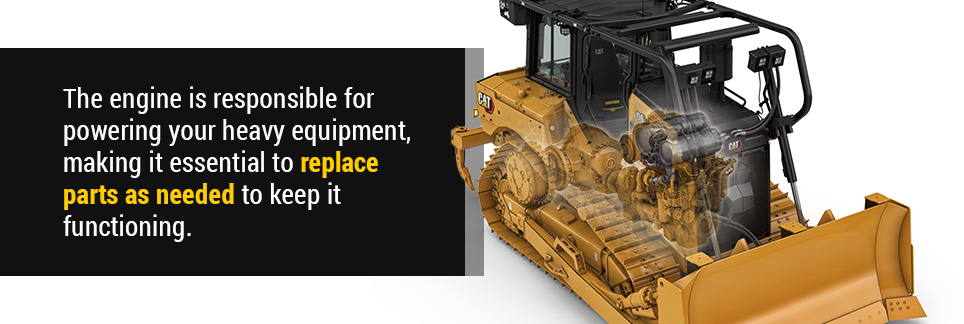
The engine is responsible for powering your heavy equipment, making it essential to replace parts as needed to keep it functioning. Common engine replacement parts include:
Brake system parts can include brake pads, calipers, brake lines and discs — all critical to operating the equipment safely and stopping efficiently. While they can last thousands of miles if used properly, frequent braking and riding on inclines can wear them faster. Squealing sounds, fluid leaks or braking-related vibrations are all signs your brakes need to be replaced.
Batteries on heavy equipment may need to be replaced periodically due to age, wear, sulfation, loss of capacity, or failure to hold a charge. Diesel engines often have two batteries to start the system and supply energy to the electrical components within your machinery. The average original equipment manufacturer (OEM) battery lasts a few years, though you should replace it when necessary. Batteries can fail due to improper charging, corrosion or loose cables.
Pay attention to critical electrical components and when they may need replacing. These can include alternators, sensors, wiring harnesses and starters. Spark plugs also require replacements, as they create the ignition to begin combustion and start your heavy equipment. Replacing them as needed can reduce harmful emissions, help with smooth engine starts and maximize fuel economy.
Common filters you will need to regularly replace on your heavy machinery include:
You might also replace cabin components over time, such as seats, mirrors, controls, HVAC systems and gages, for better comfort and safety.
Undercarriage components can include rollers, sprockets, tracks and idlers. These parts support and propel your heavy equipment. Wear parts can include bushings, wear plates, pins, bearings and cutting edges, and teeth. The bucket teeth and cutting edges are specifically used in excavation and material handling tasks.
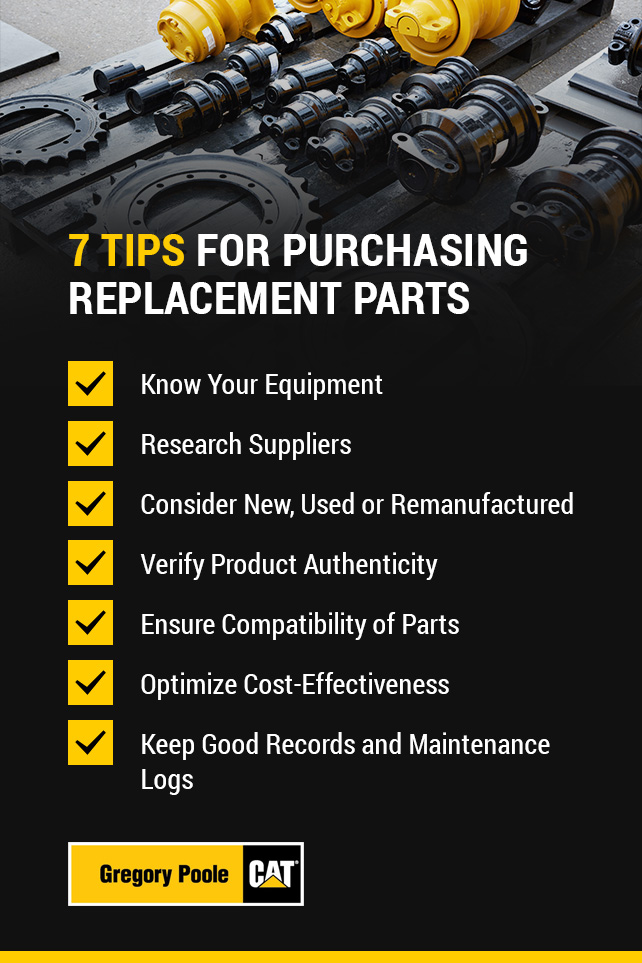
Follow these guidelines to select the right replacement parts for your heavy equipment. By carefully considering these factors, you can ensure you get authentic, high-quality components that are compatible with your equipment model and sourced from a reputable supplier.
Before shopping for replacement parts, you’ll need a deep understanding of the machinery you’re working with. Different equipment models have specific parts unique to them. Therefore, you should know the machine’s make, model, year of manufacture, serial number and other relevant specifications. Review the manual for an in-depth guide on the information you need before browsing replacement parts.
Additionally, consider the environment in which the machinery operates. If you’re working in dusty or wet environments, be sure the parts have protective features to keep your equipment in good condition. Understanding your equipment’s environment can help you choose durable parts that can withstand harsh conditions.
You’ll want to work with a top-quality supplier to ensure you get top-quality replacement parts. Consider the following points to help you choose the right company:
Many suppliers offer both new, used and remanufactured parts. Here are the pros and cons of each:
Before purchasing replacement parts, verify that the product is genuine OEM or high-quality aftermarket to ensure compatibility and performance. Aftermarket parts come from third-party sellers, and carriers typically don’t test them for compatibility with your equipment, which can lead to malfunctions. For this reason, experts often recommend using OEM parts for your replacements.
Check for the proper packaging, labels and markings that indicate authenticity and quality standards. Verify the serial numbers or part codes, ensuring they match the manufacturer’s specifications for authenticity. Opt for parts that come with warranties to protect against defects or malfunctions.
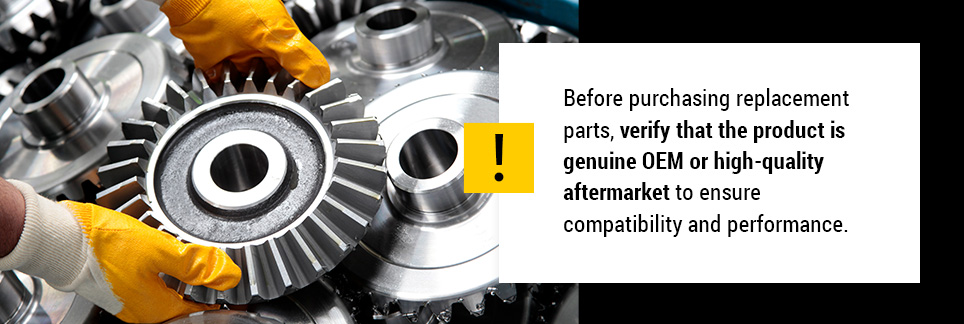
Consult with experts to make sure you’re getting the correct specifications and requirements for your replacement parts. You can also refer to your equipment’s manual to ensure compatibility. Cross-reference the manufacturers’ part numbers to ensure they match your specific equipment model.
Seek advice from technicians and mechanics at your chosen provider. They have the knowledge and expertise to help you find the right replacement parts for your specific equipment. Visually inspect the replacement parts at the dealer, confirming that they are free of damage and feature the correct weight, size and dimensions before purchasing.
Think about your budget and how to optimize cost-effectiveness when choosing replacement parts. Consider the following:
After buying replacement parts, keep a record of the purchase, including the part’s specifications, purchase date and cost. Indicate when repairs are made and the parts that are replaced. Keeping good records and maintenance logs can help you identify patterns and plan for future replacements. It also helps you establish a maintenance schedule to minimize downtime and breakdowns.
When it comes to purchasing replacement parts, choosing a reputable supplier may be the most important decision you make. This way, whether you choose new, used or remanufactured parts, you’ll know you’re getting top-quality components that match your specific machine. Gregory Poole Equipment Company offers high-quality replacement parts and a team of experts to help you find the right component for your equipment.
We’ll support you in all stages of the replacement process, answering your questions and considering your needs to determine the best parts for your equipment and projects. Our selection includes a wide variety of replacement parts, including high-quality Cat® components and other quality manufacturing brands. We also offer financing options to meet your budgetary needs.
To purchase the right replacement parts for your equipment, consider the supplier, the type of part you need and compatibility with your machine and needs. With a focus on great service and exclusive partnerships with some of the top manufacturers, Gregory Poole is your one-stop shop for your heavy equipment needs. We offer new, used and remanufactured parts for your projects and excellent service every step of the way.
Browse our quality replacement parts or contact us today for help choosing the right component for your equipment.
